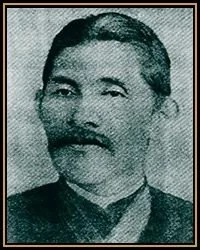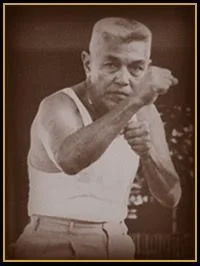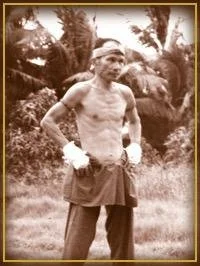Phra-Yah-W’Jee Sud-D’Yah-Ruk
The ruler of Chumphorn province (the father of his paternal grandmother) was the Siamese general who attacked Mergui and Teneserim in Burma back under the rule of Siam on the 2nd of May in 1824, his son-in-law, Phraya Sri Rajasongkram. Phraya Sri Rajasongkram became the governor of Chaiya, was the grandfather of Phraya Wacheesatyarak. Sri Rajasongkram had a son named Kham who became a soldier working for King Rama IV in the court of Somdech Chao Phraya Srisuriyawong who was the minister of defense during that reign. Sri Rajasongkram received a promotion from the king to be the secretary of the governor of Chaiya when he was 25.
Kham helped to put down the Chinese rebellion in Phuket. Once the rebellion was over, the Chinese fled into the ocean, and Kham was promoted to the highest rank in the city of Chaiya. But the fight against the Chinese rebels was not over; those who had fled into the ocean began looting and attacking coastal seaports and towns from the southern most cities of Siam up north into Prachuab Khirikhan province. Two Royal Navy ships with 200 men were sent to aid Phuket against the raids. Even though Kham (by then promoted to Phraya Vijitbhakti Bijaisongkram) was in charge of the city of Chaiya, he was also responsible for the defence of Chumphorn and Kanchnadisth cities as well. To facilitate the defence of those southern coastal cities, he invented, for the first time in Siamese history, hand grenades. This was done by putting a gunpowder mixture into a small clay pot with pieces of ember on the lid. Once thrown, it caused the wooden ships of the Chinese pirates to burn. After 5 years, Kham was able to completely defeat the pirates, and in the year 1899, he was again granted an even higher rank for having invented a new weapon.
Finally, 7 years later, on the 27th of September in 1906, Kham was promoted to Phraya Wacheesatyarak or ‘the guardian of the words of loyalty’, to oversee the oath-giving ceremony for those who would be serving the king. He died on the 29th of March 1914.
Grandmaster “Kade Sriyapai”
Born on Sunday, the 9th of November 1905 in Chumphorn, he was the 5th and the last child of Phraya Wacheesatyarak (Kham Sriyabhai) and Kaew (Kham's spouse).
Education: He did his primary school in Sriyabhai School, which was the first school in the southern province of Chumphorn, which was built by his ancestors for the Rajgirh Dao Kanong monastery. After he was about 8 years old, he travelled to Bangkok to study the Thai language at Wat Suddhivararam temple school and did a placement exam, which put him in 8th grade. Later, he decided to go to the Catholic Assumption School to study in English until he finished secondary education.
Grand Master Khet had a great interest in sports because he viewed it as an activity beneficial for health and to create sportsmanship. In the year 1922, in a high jump tournament held in honour of the Thai soldiers returning from helping in France during World War I, Grand Master Khet took the place in the tournament. He also had a great interest in soccer and Muay Thai, and he was reputed to be the soccer star of his school and continued to play for the team as the leader for the next 17 years. The team became very well known for its talent and received many cups and medals, including in Saigon in 1944. In the 50th anniversary of his school, he received a medal made of gold with the Latin phrase 'SEMPER FIDELIS', which translates to "always loyal', which remains the only medal given by the school to any student until now (90 years).
As for his boxing experience, he began training at the age of 8 with the first teacher of his life, his father (Phraya Wacheesatyarak). He then went on to train with 12 other Muay Thai masters. It is recorded in his biography that the names of the masters who taught Grand Master Khet were:
Phraya Wachee Sriyabhai, his father
Uncle Klad Sriyabhai, the commander of the Rasmi ship.
Plong Chamnonthong, the winner of the competition held in the palace by King Rama V.
Kru Klab Indraklab, the father of a famous boxer during the 1920s.
Kru Song, from Ta Sae, Chumphorn province
Kru In Sakdech, from Chumphorn city.
Kru Dad Kanchanakorn, from Nong Thong Kam
Kru Suk Netprafai, from Sang Daed
.Kru Wan Pholpreuksa
Prince Vibulsawasdiwong Sawasdikul
Kru Kimseng Tawisid, a renowned master in Bangkok and other major cities. He was the boxing teacher for the Department of Physical Education.
Sir Visaldarunakorn (An Sarikbutr), the leading student of Grand Master Phra Jayachok
Chokchana and Grand Master Khunyi Sarasabyakorn. He was the boxing teacher in Suan Gulab school during the 1920s and wrote a guidebook for boxing for the Ministry of Education. His book was used as the standard to teach students. Though according to his biography, there were 12 boxing masters, Grand Master Khet said that there were 13.
Muay Thai, for Grand Master Khet, was more than just a form of physical training; it was a form of art passed down by the Thais of the past for the future generations to protect themselves.
Towards the end of his life, after he had retired, he dedicated most of his time teaching children to appreciate the art of Muay Thai, which is the ultimate form of martial arts. He was often invited as a guest speaker for many institutions and continued to teach until his last moments at the age of 76.
Kru Tong Yahlaa
Born on the 1st of August 1929 into a Muslim family, Kru Thonglor learned Muay Thai from Grand Master Khet Sriyabhai and also from master Kimseng Tawisid (the last boxing teacher of Grand Master Khet).
Kru Thonglor Yalae (a.k.a Thong Cheuachaiya) had been on stage at least 200 times and defeated a famous boxer from Chacheongsao. All of the leading boxers during that time had been on the stage with Kru Tonglor. He was very experienced in boxing and also in Muay Chaiya, hard to find anyone equal in talent. Kru Thonglor was one of the most important students of Grand Master Khet.
Throughout his life, he had dedicated himself to transmitting the knowledge of Muay Chaiya to his students and other people relentlessly. To those whom he deemed to be virtuous and righteous, he would teach them Muay Chaiya regardless of nationality or religion. Some of his important students are Ha and Pat.
Kru Lek
Kru Lek began training at the age of 12 by learning from his older brother, Witchanan Sodprasert (a student of master Kimseng Tawisid). At that time, he was studying at Assumption School. At the age of 16, while he was studying in grade 7, he had the opportunity to read 'Fah Muang Thai' (Thai Sky) and found a column written by Grand Master Khet. He then had a great respect for Grand Master Khet and started doing research on the Grand Master's biography, and discovered that the Grand Master was the most professional and well-versed person in Muay Chaiya.
Once Kru Lek had had the opportunity to meet Grand Master Khet, he asked the Grand Master to clarify everything that he needed to know, such as the techniques of the movements. From that moment on, Kru Lek became a student of the Grand Master. When Kru Lek was 18, he enrolled in an arts college. During his years in college, he became distanced from Muay Chaiya. After he graduated at the age of 21, he then learned of the death of the Grand Master.
In the year 1981, when he was drawing an erasable ceremonial tattoo on the body of one boxer from the Isan region of Northeastern Thailand, he had the chance to meet Kru Thonglor Yalae, one of the most loved students of the Grand Master. They then discussed many interesting facts about Muay Chaiya. From that day onward, Kru Lek became a student of Kru Thonglor and had always studied Muay Chaiya from him until Kru Thonglor's death in 1996 from cancer.
(Text and images are all from the official website of ‘Baanchangthai Training Camp’)






